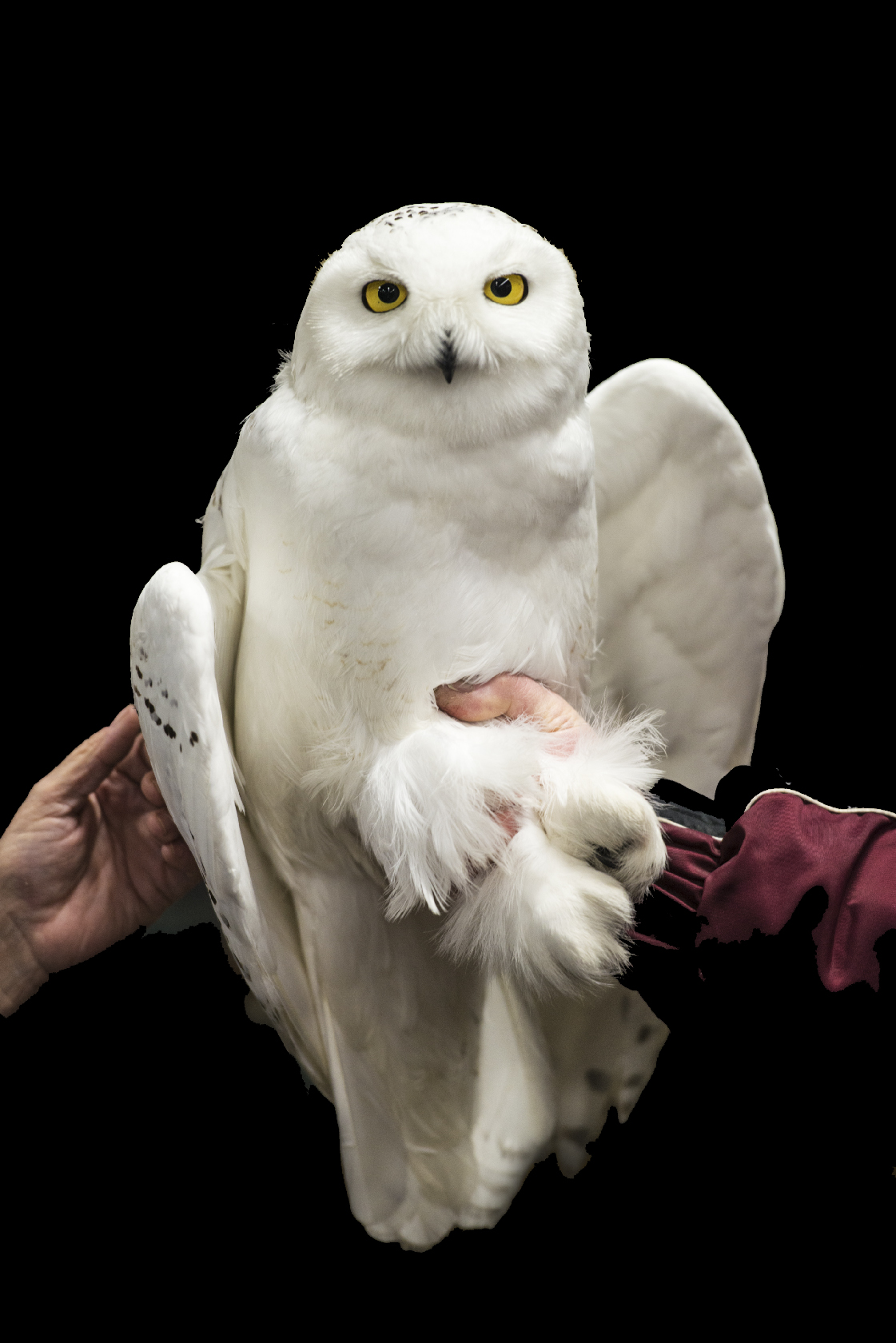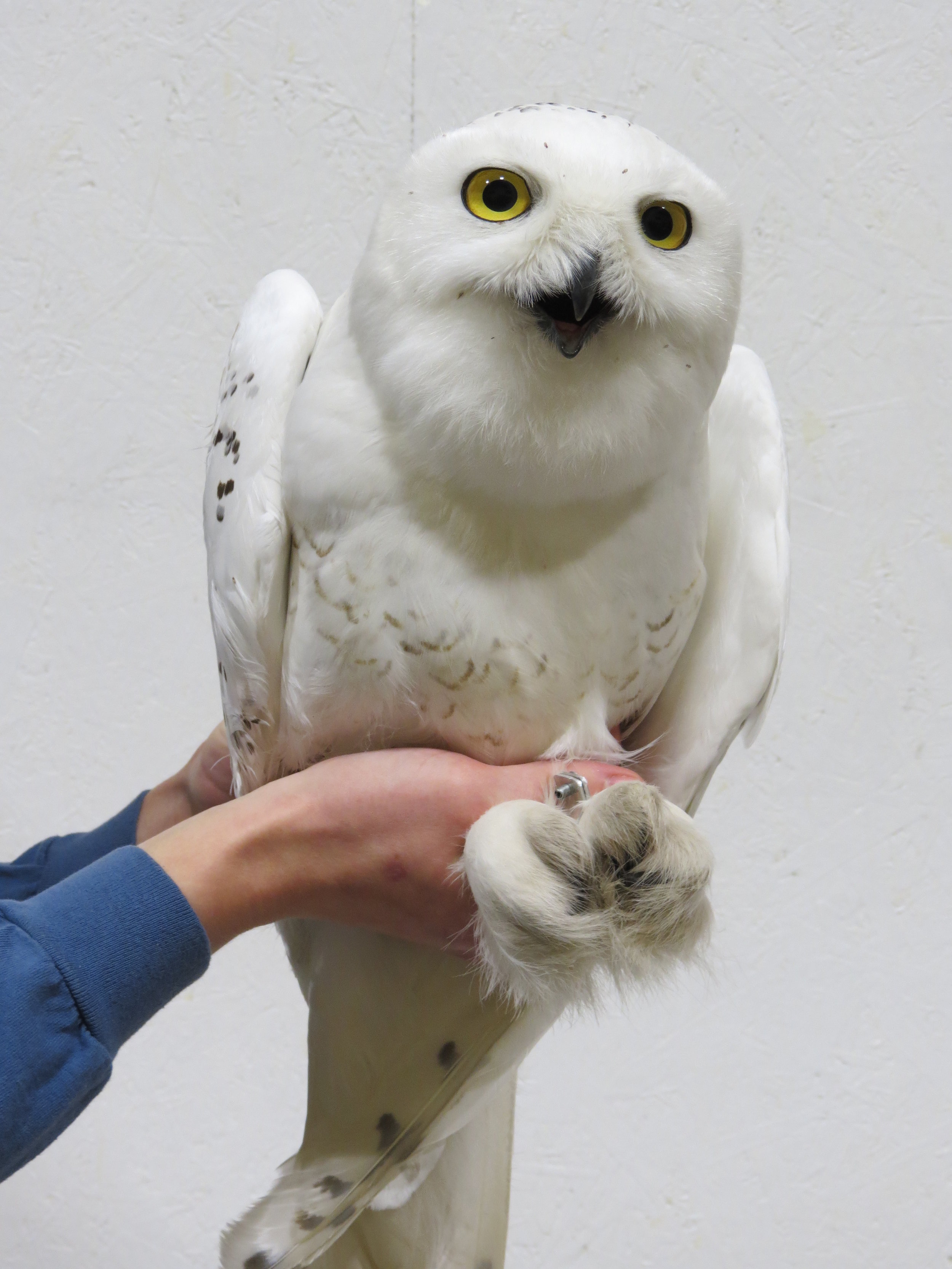Snowy Owls: Goose Pond, Arlington, and Coddington
Madison Audubon’s involvement with Project SNOWstorm began in February 2015 when Goose Pond Sanctuary experienced many observations of snowy owls as winter visitors. Project SNOWstorm was just getting started as a non-profit that studies snowy owls’ winter ecology after the historic snowy owl irruption of 2013-14.
What had once been simple (excited) observations of snowy owls near Goose Pond led to a parntership with Project SNOWstorm and local biologists to safely capture, place a transmitter on the back of, and release these birds back to the wild. We hope that those involved with “our” two snowy owls at Goose Pond — Goose Pond and Arlington — enjoy the memories of those events, and that new birders can learn about the snowy owl project. And now, we have the pleasure of watching a third owl associated with our organization: Coddington.
The three snowy owls Madison Audubon and its donors have supported as part of Project SNOWstorm. Left: Goose Pond (2015), photo by Richard Armstrong. Center: Arlington (2018), photo by Madison Audubon Society. Right: Coddington (2019), photo by Brad Zinda.
Over the past four decades snowy owls are seen infrequently at Goose Pond but sightings increased in the winter of 2013-2014 in our area. Ryan Brady, DNR Conservation Biologist provides updates on snowy owls, and this winter, 85 have been sighted in Wisconsin, but so far not on our sanctuary.
Over 75 snowy owls have been tracked by Project SNOWstorm throughout the United States and Canada, including three owls with transmitters funded by MAS donors. The first bird, “Goose Pond”, was caught and released on February 14, 2015; “Arlington” on January 4, 2018; and “Coddington” and on January 3, 2019.
Mark Martin releasing the newly tagged Goose Pond owl. Photo by Arlene Koziol
“Goose Pond” (2015)
Our first snowy owl was caught at the Central Wisconsin Airport at Mosinee, released at the UW Arlington Research Station one mile south of Goose Pond, and named after our nearby iconic wildlife sanctuary. (Conservation groups actively work on relocating owls that are found at or near airports due to the high risk for the birds and planes.) On March 19, Goose Pond flew southwest to Grant County, and his last transmitted data was six miles northwest of Dubuque, Iowa on March 29. Shortly after that his transmitter failed. We later learned that he spent time near Highway 151 near Platteville. When learning that he moved to a rural area in Grant County, Mark Martin, Matt Reetz, and raptor biologists from Eagle Valley tried trapping him so that his failed transmitter could be removed, but were unsuccessful.
Arlington’s piercing gaze is unforgettable. Photo by David Rihn.
“Arlington” (2018)
Of all the transmitted owls in the Midwest, Arlington made the most movements away from and back to his release sight at the UW Farms. Project SNOWstorm scientist Scott Weidensaul wrote in the February 18, 2018 Project Snowstorm blog that “Arlington took a little walkabout Feb. 12-13, making a 90-mile (144 km) jaunt east to the outskirts of Watertown, south to Lake Koshkonong, and then back up to his normal (Arlington) territory.” Arlington later took a cruise to Rush Lake near Ripon and returned. That April, the Midwest was hit with giant spring snowstorms, delaying the bird’s migration back to the tundra.
A map of Arlington’s extensive travels while in Wisconsin. Image provided by Project SNOWstorm.
From Project SNOWstorm’s May 13, 2018 blog: “…there’s been a lot going on, so let’s bring everyone up to speed. Unfortunately, the biggest news is also the saddest. Arlington, who was tagged Jan. 4 at Madison Audubon’s Goose Pond Preserve near Arlington, Wisconsin, was found dead along a roadside in Benton County, Minnesota, on April 29. Although we’ll conduct a necropsy to be sure, it appears he was killed by a vehicle collision — our third such loss this winter. A passerby saw a snowy owl sitting along a country road, not moving, and when they returned half an hour later, the owl — Arlington — was lying dead.
We’re deeply grateful to Carroll Henderson and the other folks at Minnesota DNR, who recovered Arlington, for reaching out to us immediately and making arrangements to have him and his transmitter shipped to us — just another example of the terrific cooperation we’ve enjoyed over the years from state, provincial and national wildlife agencies. And we’d like to again extend our thanks to Madison Audubon for sponsoring Arlington’s transmitter — this is a hard loss for them as well as us, but Arlington’s movement data is and will remain a valuable legacy.”
Project SNOWstorm sent us the results of his necropsy that found low (sublethal) levels of Brodifacoum rodenticide, and also DDE, the breakdown product of DDT, which we find at varying levels in many snowy owls, and significant levels of mercury. We’re looking hard at what such toxins mean for snowy owl health. He had a moderately heavy load of parasitic nematodes, which we’ve seen at fatally high levels in some snowy owls.
Fortunately, Project SNOWstorm was able to recover Arlington’s transmitter and refurbish it for another bird in the future. While Arlington’s death was a blow, the prospects of tagging another owl with the transmitter gives Arlington’s followers and the donors to the $3,000 transmitter a second chance to hope.
Coddington, the snowy owl outfitted with Arlington’s transmitter, in profile. Photo by Brad ZInda.
“Coddington” (2019)
And a second chance came this winter! Coddington, an adult male snowy owl, was caught and released at Buena Vista Marsh on January 3, 2019 and outfitted with “Arlington’s” transmitter. The perils of winter life for snowy owls continue, however, as we learned this week that he made a narrow escape from disaster with help from a farm family in Plover and the Raptor Education Group, Inc. (REGI). Likely after chasing prey into a barn and getting stuck inside, and in a lagoon of cow manure no less, Coddington was rescued by the Biadasz family, cleaned up, examined, and is currently in rehab with REGI.
Because Coddington will be in rehab and stationary for three to four weeks, his transmitter was removed and we’re hoping to be able to capture, tag, and release another snowy owl with that transmitter. We are so glad Coddington will recover and in time to migrate north!
Arlington sits at the rock quarry outside of Goose Pond Sanctuary in 2018. Photo by Monica Hall
As you can see, snowy owls — indeed, most bird species — face numerous challenges when interacting with the human world. But programs like Project SNOWstorm, which work to understand those specific challenges, people like you and I, who work hard to take action to help birds like Goose Pond, Arlinton, and Coddington, can make a world of difference.
Thank you to:
Project SNOWstorm for establishing and coordinating the snowy owl winter ecology research project. Their staff of volunteers is great to work with!
Gene Jacobs, Raptor Biologist with Linwood Springs Research Station for catching and banding the three owls.
MAS members that donated to funding two transmitters and to donors to Project SNOWstorm.
Everyone who provided sightings and photos, and helped trap the owls.
The staff at UW Arlington Research Farms for their reports and cooperation.
Together, we can make a difference!
Written by Mark Martin and Susan Foote-Martin, Goose Pond Sanctuary resident managers, and Brenna Marsicek Madison Audubon director of communications












